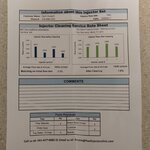- Thread starter
- #51
jakk220
10+ Year Contributor
- 1,319
- 312
- Nov 13, 2010
-
Akron,
Ohio
Post a good 3rd gear pull and I'll tweak your VE table, and set global where it should be. You can then do a pull on that tune and see where you're at. I also need a shot of your injecor flow rates, and the voltages if you have them.
Here is the injector flow chart. Getting ready to go get the log now.






 .
.












